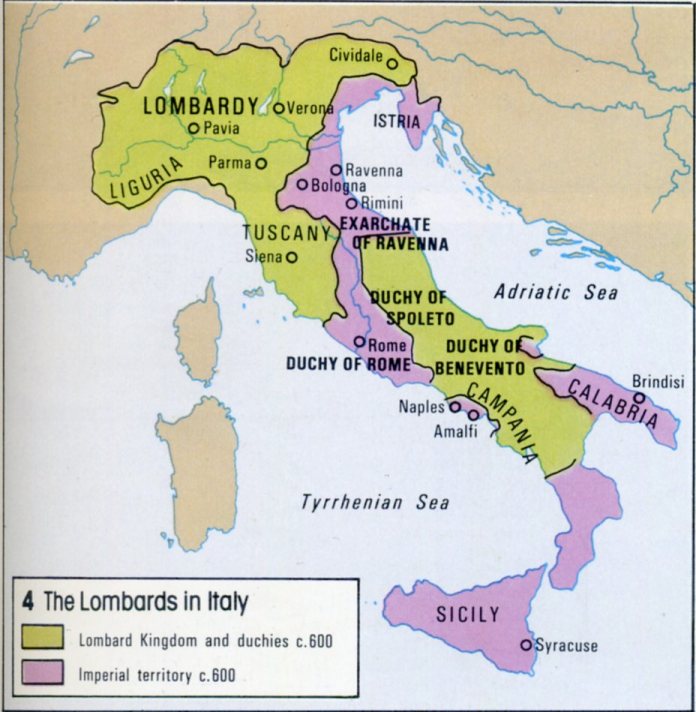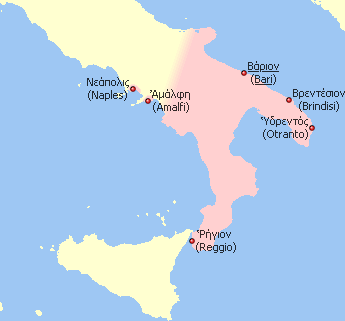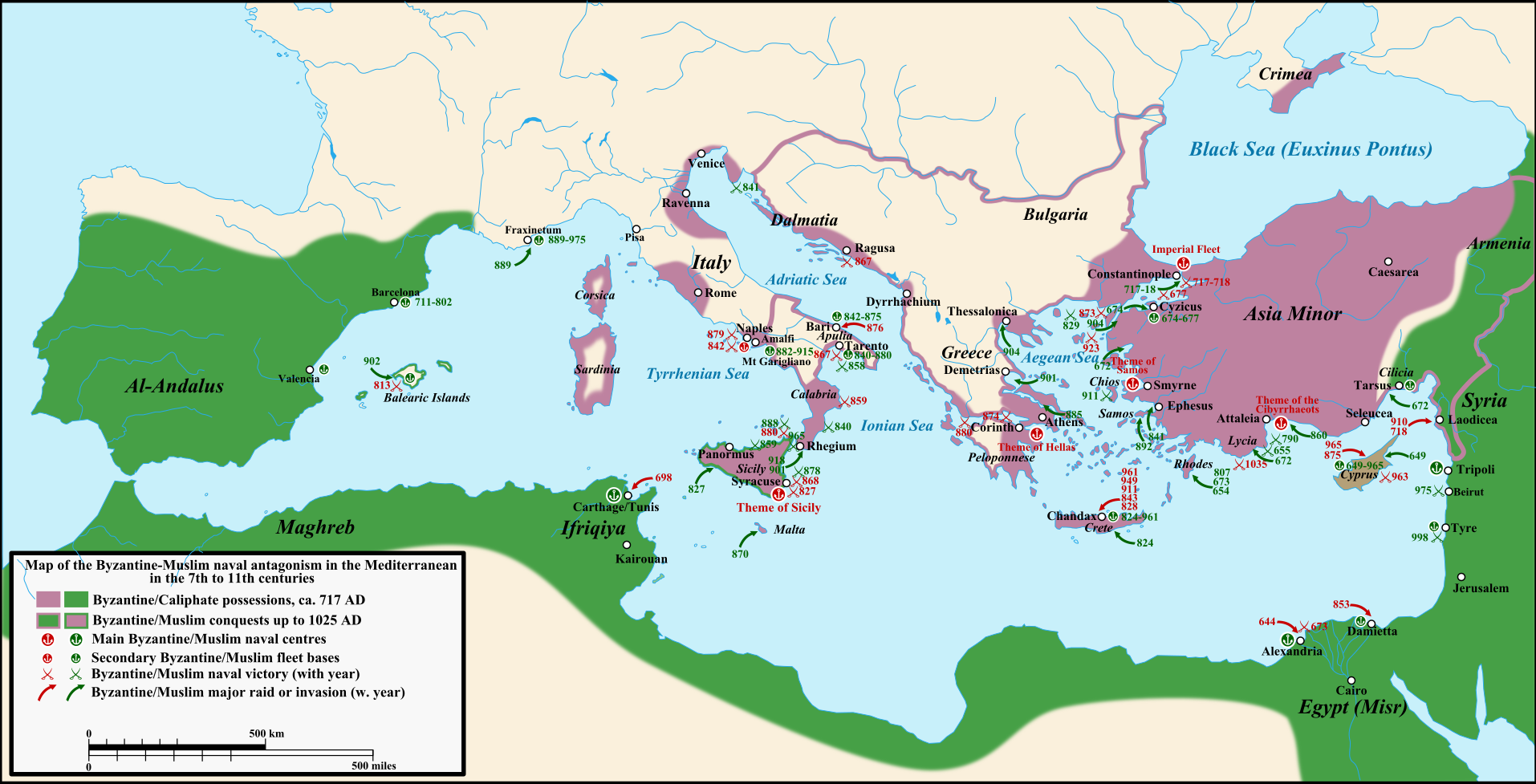When I say "Southern Italy," I'm speaking mainly about Campagna, Puglia, Basilicata, and Calabria (as well as Sicily and Sardinia). In antiquity this area was called 'Magna Graecia" or "Greater Greece," owing to the extensive colonization by the Greek city states to Italy's East. Though it was thoroughly Romanized, the region did still maintain a substantial number of Greek speakers throughout its history. Today, Southern Italy is often referred to as the Mezzogiorno, a word which literally means "midday." Roughly, this is the area controlled by the Kingdom of Sicily (and later, the Kingdom of Two Sicilies).
 |
| This kingdom was founded in the 12th century, and continued (in one guise or another) until the unification of Italy in 1861. |
 |
| Gold medallion produced under Theoderic. Note his mustache, which was a stereotypically "barbarian" style of facial hair |
These religious differences were seized upon by Justinian, the emperor of the Eastern Roman Empire (remember, the only one left at this point) as the justification of an invasion of the Germanic kingdoms of the Western Mediterranean. He essentially sold these conflicts as wars of "liberation," freeing the local (orthodox) Roman populations from their barbarian (Arian) oppressors. In reality it seems that religion was a small portion of Justinian's decision to invade, but it did provide a convenient pretext. Beginning in 535, Justinian waged war against the Ostrogoths in order to regain control of the Italian peninsula. This war (as well as his campaigns in other parts of the West) took decades and caused an unbelievable amount of devastation to both the land and its inhabitants, but ultimately Justinian was fairly successful in his reconquest of the West.
This success was extremely short lived. While Justinian managed to hold this empire together, things very quickly unravelled after his death in 565. Despite spending 20 years and the entirety of the Roman treasury to regain Italy, most of the peninsula was lost to a new wave of invaders, the Lombards. With the land devastated and depopulated, the Lombards entered almost unopposed.
 |
| Most of this territory was lost within a decade of Justinian's death |
With so many problems in every corner of the empire, Byzantium had little ability or interest to interfere in Italy. While there were still pockets of Byzantine control, the local rulers were largely expected to fend for themselves. As a result, what little remained under the control of Constantinople in the North were lost, and the southern territories were under constant threat of raids and piracy by Muslims from North Africa. In fact, this lack of security and the inability to rely on military aid from Constantinople is one of the reasons that the city of Rome turned toward the Franks (and eventually Charlemagne) and away from Byzantium--but that's a story for another day.
 |
| Charlemagne being crowned Emperor of the Romans by Pope Leo III TOTALLY BY SURPRISE, OF COURSE on Christmas day, 800. |
This status quo, at least with regard to Byzantium and the Lombards, began to change in the mid 9th century (and this is also where my own research picks up). By the 860s the various crises facing the Byzantine Empire had finally begun to settle down, and under the Macedonian Dynasty Byzantium once again became the principal power in the Mediterranean world, expanding outward instead of being pushed back onto its heels. This renewed stability allowed for an increased focus on the West; while Byzantium was ultimately unable to stop the invasion of Sicily, they did make great strides on the Italian peninsula itself. The empire managed to bring a large portion of Southern Italy under its control, playing local Lombard leaders off of one another and appointing capable katepans, the title of the leaders of Byzantine Italy. These katepans were given a high degree of autonomy, perhaps owing to the distance between Southern Italy and Constantinople.
 |
| The Katepanate of Italy, in the early 11th century. |
Shifting gears a bit, let's move on to the food of Southern Italy. To a large degree, stereotypical American-Italian food is based on the cuisine of Southern Italy. Lots of tomato-based sauces. Lots of olives. Even pizza is a Southern invention, hailing from Napoli, the capital of Campagna. This food also tends to be on the spicier side, though that is not a hard and fast rule. For my last recipe, I decided to make Calabrian lamb, a dish containing lamb chops, tomatoes, red bell pepper, green olives, and onion. It's a snap to put together, and has some really great flavors. The sauce ingredients I'm about list should be enough for about 4 servings, and you would probably want 2 chops per person (depending on the size). Go get the following: Lamb chops (you want rib chops; shoulder chops need longer cooking, and this is not a low-and-slow recipe); 1 can tomatoes (14 oz, San Marzano if you can find them, other Roma tomatoes if not); 1 small onion; ~1/4 cup green olives, pitted; 1 red bell pepper; parsley (I unfortunately didn't have this, as it had spoiled in my fridge...); red pepper flakes; olive oil; salt and pepper.
Take all of those ingredients and get them ready: crush the tomatoes up with your hands, dice the onion, peel the red pepper and cut into ~1" chunks, and coarsely chop the olives.
 |
| Peppers and olives, and the tomatoes. |
 |
| Lamb and onion. Ideally you'll have better looking lamb cuts than this, but I was working with what I had... |
 |
| I would not put more than one more cop in this pan, or it'd be too full. Work in batches if necessary, and resist the urge to move them around too much; you want them to get a nice sear. |
...remove the chops to a plate and start on the sauce. Reduce the heat slightly and add your onion and crushed red pepper to taste.
Keep them moving until they get a nice golden brown. Don't let them burn! Once the onions are done (~5 minutes), add in your crushed tomatoes.
Let the tomatoes cook for another 5 minutes or so to cook some of the liquid down, and then add in your red peppers and olives.
You also want to season at this point; I needed to add a touch of salt and a few healthy cranks of black pepper. Let this cook for a few minutes to let all these flavors get acquainted. You don't want the mixture to get too dry, so adjust the heat as needed. After another 5 minutes or so, add the chops back in.
Let this cook a few minutes more, until the chops are the correct doneness and the consistency of the sauce is to your liking. You want the peppers to still have some snap to them; don't let them get mushy!
You could serve this with a starch of some kind, but I don't think it's necessary. Just have some good crusty bread and enjoy your one pot dinner. As for what to drink, there are lots of choices. If you make this reeeeeally spicy, you don't want anything with too much tannin. Assuming that you haven't made nuclear lamb chops though, I think that your best bet is some Aglianico.
Aglianico (pronounced ahl-YAH-nee-koh) is a grape grown primarily in Southern Italy. It's origins aren't known for sure, but it's believed to have originally come from Greece. You can find it in a number of different Southern wines, but the main two that you're likely to encounter in the US are Taurasi and Aglianico del Vulture.
Sometimes referred to as the "Barolos of the South," Taurasi and Aglianico del Vulture are produced on opposite sides of the dormant volcano Mt. Vulture, the former in Campagna and the latter in Basilicata (in fact it's the only DOCG wine from the region). The volcanic soil help to give these wines their character. These are big, bold reds, with lots of acidity and lots of tannins that can hold up to a considerable amount of aging. You can expect a lot of earth and spice on the palate, though in some instances (such as the bottle I opened for this meal), you can get something a little more fruit forward. Look for bottles from Mastroberardino for Taurasi, and Paternoster for Aglianico del Vulture. My first taste of this grape was in Asheville, NC, and that bottle would be a great choice as well:
 |
| It's a fairly distinctive label, too |






